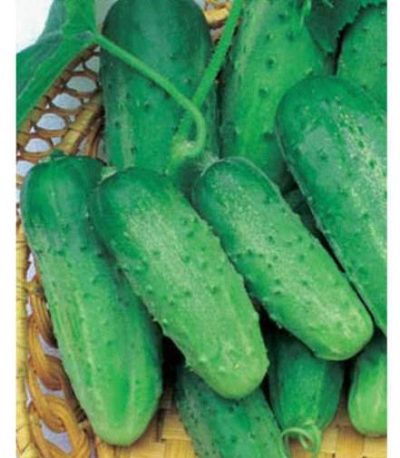
- Name synonyms: Monastirsky
- Year of approval: 2008
- Growth type: medium-sized, indeterminate
- Fruit weight, g: 95
- Fruit color: green, with light stripes of medium length
- Ripening terms: mid-early
- Pollination: bee-pollinated
- Fruit shape: cylindrical
- Fruit taste: no bitterness
- Scent: fragrant
The Monastyrsky cucumber variety (synonym Monastirsky) is an excellent representative of the category of universal use and cultivation. Monastic is grown on private estates and on an industrial scale, since it has many positive qualities, and seed material is in high demand.
Description of the variety
Non-parthenocarpic variety obtained for private and industrial cultivation in the open field or under temporary film protection from the cold, since it requires insect pollination. If the cultivation takes place in closed heated greenhouses, then the owners expect in advance additional financial costs for the acquisition of bumblebee and bee colonies responsible for the formation of ovaries. The fruits have good marketability and keeping quality, are unpretentious in care, have a strong immunity, and have good stress resistance to negative weather changes.
Characteristics of the appearance of plants and zelents
The indeterminate variety Monastyrsky is characterized by unlimited growth, which makes plant formation activities mandatory. Medium thick lashes are covered with green foliage of medium size, with well visible veins on the inner side of the leaf and slightly noticeable pubescence. The variety blooms with yellow flowers of a mixed type, fruiting is not bundle. Zelentsy have sizes:
length - 9-11 cm;
gherkins weight - 95 grams.
Cylindrical fruits are colored unevenly - a slight light streak of medium length stands out. Sparse tubercles are pubescent with black spines.
Purpose and taste of fruits
Zelentsy varieties Monastyrskiy are intended for the preparation of summer and winter salads, fresh consumption, for whole-fruit canning in the form of pickles and salting. Juicy, dense and crunchy pulp does not contain bitterness and has a pleasant refreshing and balanced taste with a slight sugar content and a bright aroma.
Maturation
The variety belongs to the mid-early category, from the appearance of the first shoots to the first cucumbers, an average of 41-45 days pass. The exact dates cannot be specified, since the variety is adapted for almost the entire territory of the country, and in the southern regions the plants begin to bear fruit earlier than in the northern regions.
Yield
Monastyrskiy belongs to high-yielding varieties: average indicators are 3 kg / sq. m.
Growing regions
The variety is adapted for cultivation throughout the vast country. These are the Central Black Earth Region, the northern, Northwestern, Central, Volgo-Vyatka, North Caucasian, Middle Volga, Lower Volga, Ural, West Siberian, East Siberian and Far Eastern regions.
Landing scheme
The optimal distance between the bushes is 40x40 cm.
Growing and caring
Cucumbers are grown in seedling and non-seedling (direct sowing) methods. The timing of sowing seeds for seedlings depends on the area of cultivation. In the southern regions, they sow in April, and the dates are pushed closer to temperate latitudes. Sowing in open ground is carried out when the soil has warmed up to + 16ºC.Seedlings are transplanted to a permanent place in the presence of 2-4 true leaves: in greenhouses earlier than on the exhaust gas.
Further care of the plantings consists in watering, weeding, loosening and hilling. For top dressing, nitrogen fertilizers are needed at the first stages of development, after the formation of ovaries, potassium-phosphorus fertilizers are applied. Throughout the growing season, you can periodically feed the cucumbers with mullein or nettle infusion, adding bread leftovers to the green infusion. The frequency of application of nutrients is every decade.
Watering is carried out regularly - once every 2-3 days, using warm, settled water. It should be borne in mind: the ground must be constantly wet, however, the formation of stagnant water is unacceptable, otherwise the roots may rot. Weeding eliminates weeds that are competing for nutrients. Hilling may be required when the root system is exposed; otherwise, it is important to prevent the appearance of an earth crust that impedes the supply of oxygen. Loosening can successfully replace mulching the surface of the root areas.
Monastic is prone to excessive branching, so you should carefully monitor the formation of ovaries and remove excess shoots, on which mostly barren flowers (male flowers) are formed.
Soil requirements
The plant prefers to grow in sunny places, protected from cold northerly winds and constant drafts. The soil should be light, loose and breathable, fertile and moderately acidic. Acidic soils require the introduction of dolomite flour, lime, chalk or gypsum. To create friability, seasoned sawdust is introduced (fresh ones take nitrogen from the soil), fallen leaves, river sand. To achieve the required level of fertility, organic matter (humus, compost, bird droppings) and mineral complex fertilizers are introduced.

In order to collect strong, tasty and beautiful cucumbers on your site, you need to make top dressing. Lack of nutrients can negatively affect the appearance of the plant and significantly reduce the yield. Fertilize cucumbers with organic fertilizers in combination with mineral fertilizers. With the right balance of these components and adherence to the fertilizing schedule, the cucumber yield will be maximum.

Despite their popularity, cucumbers are often attacked by diseases and pests. From them, cucumber plantings often die before the start of fruiting. In order to prevent this from happening, it is necessary to try to prevent ailments or get rid of them at the very beginning, having studied in detail their causes of occurrence, signs and methods of treatment.





























































































